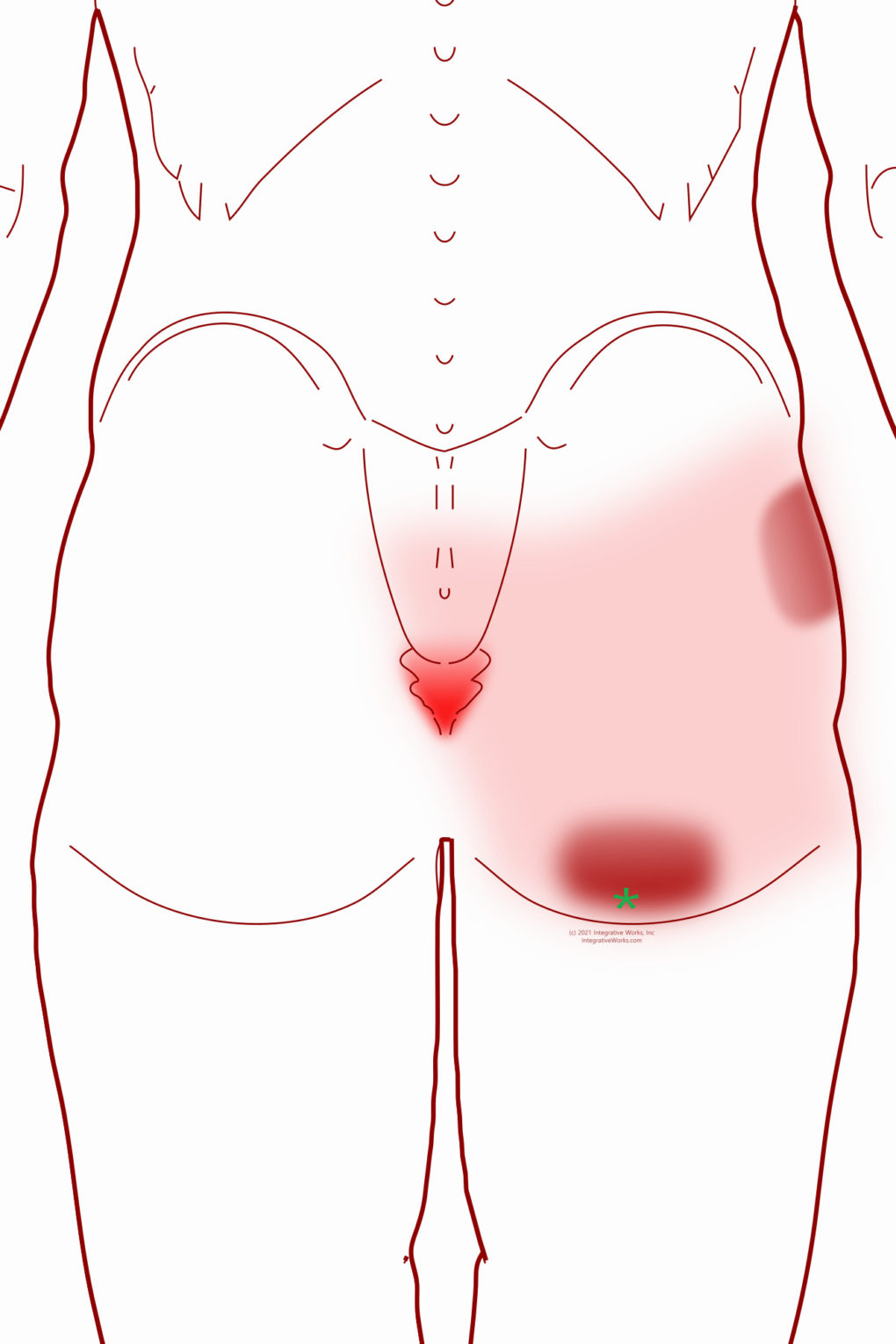Tailbone or Lower Hip Pain When Seated
Table of Contents
- How People Describe This Pain Pattern
- How You Activate and Intensify This Pain Pattern
- Self-Care – Getting Relief on Your Own
- Musculoskeletal Anatomy Behind Your Pain
- Therapy Notes for Massage and Bodywork
How People Describe This Pain Pattern


People complain of pain in the tailbone while seated for long periods. Usually, it bothers them after a long drive in the car or sitting in a theater for long periods. Often, they have a unique pillow that prevents pressing on the tailbone, but it doesn’t help.
People may also complain of pain around the bone that presses into the seat. Like the first example, these people can’t stay seated long and squirm onto one side or the other.
Or tenderness…
Instead of pain, people may refer to tenderness in the darker areas of this illustration. In those cases, they often mention it as an aside and are not why they came for treatment.
Likewise, some people also complain of a general tenderness over the entire buttock. They may have more intense pain in the darker areas when seated, pressed, or during vigorous activity.
How You Activate and Intensify This Pain Pattern
Slumping While Sitting
Sitting with your hips pulled forward in the seat aggravates these trigger points. This is more common when the low back muscles are weak and sitting up straight is tiring.
Forceful Hip Exercise
Vigorous hiking, swimming, stair climbing, or step classes can aggravate this pain in the tailbone or lower hip. A few of my clients developed this pain in the tailbone after swimming in a cold lake.
Injurious Onset
There are other, less common ways to aggravate this trigger point. A strike to the hip, especially the tailbone, can create joint problems and perpetuate this problem. However, a fall on the lower hip that bruises the muscle and jars the hip joints can create this pattern. Occasionally, vaccination or other shot to the hip aggravates this condition.
The Musculoskeletal Anatomy Behind Your Pain
Musculoskeletal Anatomy
This post on anatomy contains standard information about the origin, insertion, function, and innervation of muscles. Additionally, it includes information on functional considerations and anomalies.
Find Related Posts
Anatomy posts have a grid of all related posts. This includes posts on pain patterns, self-care, therapy notes, NMT protocols, cranial techniques, and cases.
Getting Relief on Your Own
Clinically Proven
Self-Care Strategies
Self-Care Posts have common sections to make them easy to follow and understand:
- Activities to Avoid or Change
- Strategies for Quick Relief
- Stretches and Exercise for Longer-Lasting Relief
- Yoga Corner
Therapy Notes for Massage and Bodywork
Better Bodywork
Through Shared Expertise
Therapy Notes provide details for cranial, spinal, and local joint work. These notes also link to a traditional neuromuscular protocol.
By treating integrative components first, direct work on the muscle becomes less intense while providing longer-lasting relief.
Support Integrative Works to
stay independent
and produce great content.
You can subscribe to our community on Patreon. You will get links to free content and access to exclusive content not seen on this site. In addition, we will be posting anatomy illustrations, treatment notes, and sections from our manuals not found on this site. Thank you so much for being so supportive.
Cranio Cradle Cup
This mug has classic, colorful illustrations of the craniosacral system and vault hold #3. It makes a great gift and conversation piece.
Tony Preston has a practice in Atlanta, Georgia, where he sees clients. He has written materials and instructed classes since the mid-90s. This includes anatomy, trigger points, cranial, and neuromuscular.
Question? Comment? Typo?
integrativeworks@gmail.com
Follow us on Instagram
*This site is undergoing significant changes. We are reformatting and expanding the posts to make them easier to read. The result will also be more accessible and include more patterns with better self-care. Meanwhile, there may be formatting, content presentation, and readability inconsistencies. Until we get older posts updated, please excuse our mess.